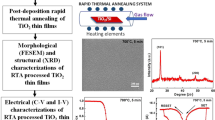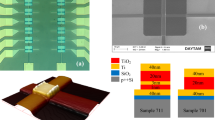Abstract
A hydrothermal process was used to grow titanium dioxide (TiO2) nanorods on p-type silicon substrates, and a dip-coating process was then used to fabricate TiO2 thin film–nanorod hybrid structures. The nanorod-like structures were obtained for processing temperatures of 160°C and 180°C. The thin films were dip-coated on the nanorods with a withdrawal speed of 1 cm/min. Afterwards, thin film–nanorod hybrid structures were annealed at 500°C for 1 h. Morphological characterization carried out by scanning electron microscopy (SEM) studies confirmed the formation of nanorods. XRD and Raman studies confirmed the presence of anatase and rutile phases of TiO2-based hybrid structures. The oxide charge density (Qox) and the interface charge density (Dit) of the hybrid structures were measured from the capacitance–voltage (C–V) plot. Qox and Dit were calculated as 2.29 × 1012 cm−2 and 0.89 × 1012 eV−1 cm−2, respectively, for a temperature of 180°C and growth time of 60 min. The resistive switching properties of TiO2-based hybrid structures showed a good on/off ratio, and hence the hybrid structure-based device can be considered a suitable element for memory devices.







Similar content being viewed by others
References
J. Hu, T.W. Odom, and C.M. Lieber, Chemistry and Physics in one dimension: synthesis and properties of nanowires and nanotubes. Acc. Chem. Res. 32, 435 (1999).
Z. Yuan and B. Su, Titanium oxide nanoribbons. Chem. Phys. Lett. 363, 362 (2002).
S.J. Kwon, H.S. Song, H.B. Im, J.E. Nam, J.K. Kang, T.S. Hwang, and K.B. Yi, Preparationand characterization of rutile-anatase hybrid TiO2 thin film by hydrothermal synthesis. Clean Technol. 20, 306 (2015).
S.S. Mali, C.S. Shim, H.K. Park, J. Heo, P.S. Patil, and C.K. Hong, Ultrathin atomic layer deposited TiO2 for surface passivation of hydrothermally grown 1D TiO2 nanorod arrays for efficient solid-state perovskite solar cells. Chem. Mater. 27, 1541 (2015).
Y.R. Park and K.J. Kim, Structural and optical properties of rutile and anatase TiO2 thin films: effects of Co doping. Thin Solid Films 484, 34 (2005).
N. Tripathy, S.P. Ghosh, and J.P. Kar, Transformation of sputtered calcium copper titanate thin film into nanorods by sequential annealing. Ceram. Int. 44, 4052 (2018).
C. Zhang, Y. Yan, Y. Sheng Zhao, and J. Yao, Synthesis and applications of organic nanorods, nanowires and nanotubes. Annu. Rep. Prog. Chem. Sect. C 109, 211 (2013).
S.J. Limmer, T.P. Chou, and G.Z. Cao, Electrophoretic deposition fundamentals and applications a study on the growth of TiO2 nanorods using sol electrophoresis. J. Mater. Sci. 9, 895 (2004).
G. Cao, Growth of oxide nanorod arrays through sol electrophoretic deposition. J. Phys. Chem. B 108, 19921 (2004).
F. Neri and E. Mininno, Memetic compact differential evolution for Cartesian robot control. IEEE Comput. Intell. Mag. 5, 54 (2010).
J.S. Meena, S.M. Sze, U. Chand, and T.Y. Tseng, Overview of emerging nonvolatile memory technologies. Nanoscale Res. Lett. 9, 1 (2014).
C. Jia, F. Wang, C. Jiang, J. Berakdar, and D. Xue, Electric tuning of magnetization dynamics and electric field-induced negative magnetic permeability in nanoscale composite multiferroics. Nat. Publ. Gr. 1, 1111 (2015).
I. Daniele, Resistive switching memories based on metal oxides: mechanisms, reliability and scaling. Semicond. Sci. Technol. 31, 63002 (2016).
M. Shahsavari, Memristor technology and applications: an overview memristor technology and applications—an overview Mahyar Shahsavari. IEEE Electron Device Lett. 39, 500 (2018).
J.M. Song and J.S. Lee, Self-assembled nanostructured resistive switching memory devices fabricated by templated bottom-up growth. Sci. Rep. 6, 1 (2016).
S.S. Mali, C.A. Betty, P.S. Patil, and C.K. Hong, Synthesis of a nanostructured rutile TiO2 electron transporting layer: via an etching process for efficient perovskite solar cells: impact of the structural and crystalline properties of TiO2. J. Mater. Chem. A 5, 12340 (2017).
C.Y. Lin, C.Y. Wu, C.Y. Wu, T.Y. Tseng, and C. Hu, Modified resistive switching behavior of ZrO2 memory films based on the interface layer formed by using Ti top electrode. J. Appl. Phys. 102, 1 (2007).
W. Shen, R. Dittmann, U. Breuer, and R. Waser, Improved endurance behavior of resistive switching in (Ba, Sr) TiO3 thin films with W top electrode. Appl. Phys. Lett. 93, 222102 (2008).
S.R. Mohapatra, T. Tsuruoka, T. Hasegawa, K. Terabe, and M. Aono, Flexible resistive switching memory using inkjet printing of a solid polymer electrolyte. AIP Adv. 2, 022144 (2012).
R.G. Breckenridge and W.R. Hosler, Electrical properties of titanium dioxide semiconductors. Phys. Rev. 91, 793 (1953).
B.M.S. Sander, M.J. Côtø, W. Gu, B.M. Kile, and C.P. Tripp, Template-assisted fabrication of dense, aligned arrays of titania nanotubes with well-controlled dimensions on substrates. Adv. Mater. 04469, 2052 (2004).
B.B. Lakshmi, P.K. Dorhout, and C.R. Martin, Sol–gel template synthesis of semiconductor nanostructures. Chem. Mater. 4756, 857 (1997).
A.S. Attar, S. Mirdamadi, F. Hajiesmaeilbaigi, and M.S. Ghamsari, Growth of TiO2 nanorods by sol–gel template process growth of TiO2 nanorods by sol–gel template process. J. Mater. Sci. Technol. 1, 611 (2007).
N. Prepared, L. Coating, and P.M. Templates, Nanotubes Prepared by Layer-by-Layer Coating, 1849 (2003).
Y. Wu and P. Yang, Direct observation of vapor–liquid–solid nanowire growth. J. Am. Chem. Soc. 123, 3165 (2001).
S.K. Pradhan, P.J. Reucroft, F. Yang, and A. Dozier, Growth of TiO2 nanorods by metalorganic chemical vapor deposition. J. Cryst. Growth 256, 83 (2003).
M. Paulose, K. Shankar, S. Yoriya, H.E. Prakasam, O.K. Varghese, G.K. Mor, T.A. Latempa, A. Fitzgerald, U.V. Park, and V. Pennsyl, Anodic growth of highly ordered TiO2 nanotube arrays to 134 µm in length. J. Phys. Chem. B 110, 16179 (2006).
J. Shi and X. Wang, Growth of rutile titanium dioxide nanowires by pulsed chemical vapor deposition. Cryst. Growth Des. 11, 949 (2011).
J. Lee, D. Hong, S. Hong, and J. Young, Sensors and actuators B : chemical short communication A hydrogen gas sensor employing vertically aligned TiO2 nanotube arrays prepared by template-assisted method. Sens. Actuators B Chem. 160, 1494 (2011).
M. Iraj, F.D. Nayeri, E. Asl-Soleimani, and K. Narimani, Controlled growth of vertically aligned TiO2 nanorod arrays using the improved hydrothermal method and their application to dye-sensitized solar cells. J. Alloys Compd. 659, 44 (2016).
C. Tan and H. Zhang, Wet-chemical synthesis and applications of non-layer structured two-dimensional nanomaterials. Nat. Commun. 6, 1 (2015).
V. Senthilkumar, A. Kathalingam, V. Kannan, K. Senthil, and J.K. Rhee, Reproducible resistive switching in hydrothermal processed TiO2 nanorod film for non-volatile memory applications, Sens. Actuators A Phys. 194, 135 (2013).
F. Zhang, X. Gan, X. Li, L. Wu, X. Gao, R. Zheng, Y. He, X. Liu, and R. Yang, Realization of rectifying and resistive switching behaviors of TiO2 nanorod arrays for nonvolatile memory. Electrochem. Solid-State Lett. 14, 422 (2011).
M. Xiao, K.P. Musselman, W.W. Duley, and Y.N. Zhou, Reliable and low-power multilevel resistive switching in TiO2 nanorod arrays structured with a TiOx seed layer. ACS Appl. Mater. Interfaces 9, 4808 (2017).
A.C. Khot, N.D. Desai, K.V. Khot, M.M. Salunkhe, M.A. Chougule, T.M. Bhave, R.K. Kamat, K.P. Musselman, and T.D. Dongale, Bipolar resistive switching and memristive properties of hydrothermally synthesized TiO2 nanorod array: effect of growth temperature. Mater. Des. 151, 37 (2018).
B. Sun, Y. Liu, F. Lou, and P. Chen, White-light-controlled resistive switching chearacteristics of TiO2/Cu2O composite nanorods array. Chem. Phys. 457, 28 (2015).
S. Roy, N. Tripathy, D. Pradhan, P.K. Sahu, and J.P. Kar, Applied surface science electrical characteristics of dip coated TiO2 thin films with various withdrawal speeds for resistive switching applications. Appl. Surf. Sci. 449, 181 (2018).
B. Mishra, P. Ghildiyal, S. Agarkar, and D. Khushalani, Synthetic precursor to vertical TiO2 nanowires. Mater. Res. Express 1, 025005 (2014).
X. Meng, D. Shin, S.M. Yu, M. Park, C. Yang, J.H. Lee, and J. Yoo, Formation mechanism of rutile TiO2 rods on fluorine doped tin oxide glass. J. Nanosci. Nanotechnol. 14, 8839 (2014).
A. Kumar, A.R. Madaria, and C. Zhou, Jp100491H.Pdf, 7787 (2010).
V. Jordan, U. Javornik, J. Plavec, A. Podgornik, and A. Rečnik, Self-assembly of multilevel branched rutile-type TiO2 structures via oriented lateral and twin attachment. Sci. Rep. 6, 1 (2016).
M. Torabi, M. Drahansky, M. Paridah, A. Moradbak, A. Mohamed, F. Abdulwahab taiwo Owolabi, M. Asniza, and S.H. Abdul Khalid, We Are IntechOpen, the World’ s Leading Publisher of Open Access Books Built by Scientists, for Scientists TOP 1%, Intech i, 13 (2016).
A. Morais, C. Longo, J.R. Araujo, M. Barroso, J.R. Durrant, and A.F. Nogueira, Nanocrystalline anatase TiO2/reduced graphene oxide composite films as photoanodes for photoelectrochemical water splitting studies: the role of reduced graphene oxide. Phys. Chem. Chem. Phys. 18, 2608 (2016).
H. Pan, X. Qiu, I.N. Ivanov, H.M. Meyer, W. Wang, W. Zhu, M.P. Paranthaman, Z. Zhang, G. Eres, and B. Gu, Fabrication and characterization of brookite-rich, visible light-active TiO2 films for water splitting. Appl. Catal. B Environ. 93, 90 (2009).
C. Maheu, L. Cardenas, E. Puzenat, P. Afanasiev, and C. Geantet, UPS and uv spectroscopies combined to position the energy levels of TiO2 anatase and rutile nanopowders. Phys. Chem. Chem. Phys. 20, 25629 (2018).
C.H. Huang, J.S. Huang, S.M. Lin, W.Y. Chang, J.H. He, and Y.L. Chueh, ZnO 1–x nanorod arrays/ZnO thin film bilayer structure: from homojunction diode and high-performance memristor to complementary 1D1R application. ACS Nano 6, 8407 (2012).
P. Bamola, B. Singh, A. Bhoumik, M. Sharma, C. Dwivedi, M. Singh, G.K. Dalapati, and H. Sharma, Mixed-phase TiO2 nanotube-nanorod hybrid arrays for memory-based resistive switching devices. ACS Appl. Nano Mater. 3, 10591 (2020).
N. Mullani, I. Ali, T.D. Dongale, G.H. Kim, B.J. Choi, M.A. Basit, and T.J. Park, Improved resistive switching behavior of multiwalled carbon nanotube/TiO2 nanorods composite film by increased oxygen vacancy reservoir. Mater. Sci. Semicond. Process. 108, 104907 (2020).
D.S. Jeong, H. Schroeder, and R. Waser, Coexistence of bipolar and unipolar resistive switching behaviors in a Pt TiO2 Pt stack. Electrochem. Solid-State Lett. 10, 51 (2007).
C.H. Huang, T.S. Chou, J.S. Huang, S.M. Lin, and Y.L. Chueh, Self-selecting resistive switching scheme using TiO2 nanorod arrays. Sci. Rep. 7, 1 (2017).
Y. Yu, C. Wang, C. Jiang, I. Abrahams, Z. Du, Q. Zhang, J. Sun, and X. Huang, Resistive switching behavior in memristors with TiO2 nanorod arrays of different dimensions. Appl. Surf. Sci. 485, 222 (2019).
Acknowledgments
The authors are thankful to Prof. Pitamber Mahanandia, NIT Rourkela for the resistive switching measurements.
Author information
Authors and Affiliations
Corresponding author
Ethics declarations
Conflict of interest
The authors declare that they have no conflict of interest.
Additional information
Publisher's Note
Springer Nature remains neutral with regard to jurisdictional claims in published maps and institutional affiliations.
Rights and permissions
Springer Nature or its licensor (e.g. a society or other partner) holds exclusive rights to this article under a publishing agreement with the author(s) or other rightsholder(s); author self-archiving of the accepted manuscript version of this article is solely governed by the terms of such publishing agreement and applicable law.
About this article
Cite this article
Roy, S., Tripathy, N., Pradhan, D. et al. Fabrication and Characterization of TiO2 Thin Film–Nanorod-Based Hybrid Structures for Memristor Applications. J. Electron. Mater. 53, 347–355 (2024). https://doi.org/10.1007/s11664-023-10733-y
Received:
Accepted:
Published:
Issue Date:
DOI: https://doi.org/10.1007/s11664-023-10733-y




